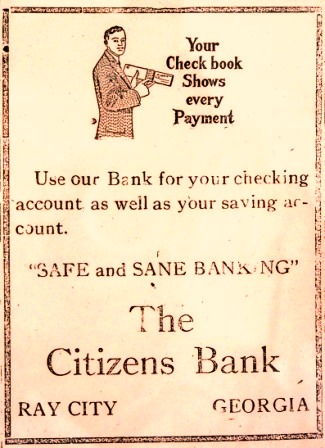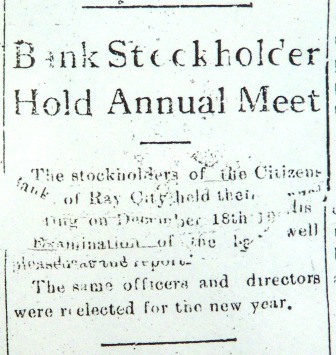In 1911, B. P. Jones, President of the Valdosta Bank and Trust, and Clarence L. Smith, Vice President, came to Rays Mill, GA on business. Jones’ wife was a daughter of Jonathan Knight, and a granddaughter of Reverend William A. Knight.
The Valdosta Times
May 23, 1911Organized Bank at Rays Mill
Messrs B. P. Jones and C. L. Smith went up to Rays Mill this morning for the purpose of organizing a Bank at that place to be known as the Bank of Rays Mill. It will have a capital stock of $25,000.
The Ray City investors received a State Bank Charter and opened for business on August 14, 1911. The other investors were: J.S. Swindle, J.H. Swindle, M.T. Bradford, W.H.E. Terry, Riley M. Green, and J. F. Sutton, all of Berrien county; and Charles Lee Jones and J.B. Griffin, of Lowndes county. The Bank of Ray’s Mill would later be known as the Citizens Bank of Ray City.
The principal banker, Benjamin Perry Jones, was a former resident of Berrien County, and had operated mercantile at Milltown where he also had a liquor dealer’s license. In 1868, during Reconstruction, Benjamin Jones, along with H. T. Peeples and James E. Williams, represented Berrien County at the organization of the Democratic Convention of the First Congressional District, convened at Blackshear, Pierce County, Georgia on September 16, 1868.
In 1913, a biographical sketch of Benjamin P. Jones was included in A history of Savannah and south Georgia:
Harden, William,. A history of Savannah and south Georgia. Chicago: Lewis Pub. Co., 1913.
p. 747-749
BENJAMIN P. JONES, the president of the Valdosta Bank and Trust Company has had a long career in business, has won prosperity and influence much above that of the average man, and yet began with little or nothing and for a number of years had a hard struggle with the obstacles of business life. Mr. Jones is one of the prominent citizens of south Georgia, and has been identified with Valdosta from the time it was a small village.
Mr. Benjamin P. Jones was born, June 25, 1837, in that part of Camden now Charlton county, Georgia. His grandfather was James Jones, thought to have been a native of Georgia, who was a Camden county planter, having a number of slaves, and died there at the age of seventy-five, his remains now reposing in the Buffalo churchyard. He married a Miss Davis, who was upwards of eighty when she died, and they reared a large family of children. They were Primitive Baptists in religion.
Burrell Jones, father of the Valdosta banker, was born in Wayne county, Georgia, April 29, 1803. About the time of his marriage he bought land near Folkston, living there a few years, and about 1840 returned to Wayne county and located on a farm near the present site of Lulaton, where he made his home until his death in 1877. He married Mary Margaret (known as Peggy) Mizell, who was born in Bulloch county, August 9, 1809. Her father, Jesse Mizell, of English stock and a native of North Carolina, was a soldier of the Revolution under Jasper at Savannah and with Marion during that leader’s valorous excursions against the British. He was with the command when it crossed the Peedee river, first lay blankets on the bridge to deaden the sound of the horses’ hoofs, and in this way surprised the enemy. Some years after the Revolution Jesse Mizell came to Georgia, living two years in Camden county, and then moved into the interior, settling near the present site of Folkston in Charlton county, where he bought land and was engaged in farming and stock raising until his death at the age of about sixty. He married a Miss Stallings, a native of North Carolina and of Dutch ancestry. Mary M. Mizell, the mother of Mr. Jones, spent her early life on the Georgia frontier, and for the lack of educational advantages she compensated by her great natural ability and force of character. Her husband was for many years an invalid, and the care of the children devolved entirely upon her. She reared them to habits of industry and honor, and they paid her all filial reverence. Her death occurred in 1885. Her nine children were named as follows: Harley, Joseph, Benjamin P., Margaret, James B., Nancy C., Harriet, Jasper N. and Newton J. Harley and Joseph were Confederate soldiers and died during their service for the southern cause.
Though in his youth he had little opportunity to obtain an education, Benjamin P. Jones managed to obtain an education largely through his own efforts at self-improvement and an ingrained habit of close observation. When he was seventeen he became a teacher, and while he did good service while in this occupation it may be remembered that qualifications for teaching were not very high at that period. Anyone could teach who could find others who knew less than himself, and there was no formality of examination. Intellectual curiosity was a passion with him from an early age, and the time most children give to play with their comrades he devoted to association in company with his elders, thus learning by listening. When he was twelve years old he once attended a court session, listening attentively to the evidence and the charge to the jury. At recess the judge asked why he was so absorbed in the proceedings. The boy replied that it was because he wanted to learn, and then asked the judge why he charged the jury as he did. That was equity, responded the judge, and after explaining the meaning of that word told the boy that if he ever had occasion to make out papers to make them out in accordance with equity and justice and he would sanction them if brought before his court. Chopping cotton at twenty-five cents a day and board was the means by which Mr. Jones earned his first money. A little later he became clerk in a general store at Lulaton, and after a time engaged in business for himself at Stockton, Georgia. Hardly had his trade started when a panic paralyzed all business, and he found himself in debt fifteen hundred dollars, which took him some time to pay off.
Early in 1861 Mr. Jones enlisted in Company D of the Twenty-sixth Georgia Infantry, and was with that command in the coast defense until the regiment was ordered to Virginia, when he secured a substitute. Confederate money was then plentiful but away below par, and he bought a farm for three thousand dollars, at war-time prices, going in debt for the greater part of this amount. He was busily engaged in farming until 1864, when he enlisted with the Georgia Reserves, being commissioned first lieutenant and being in actual command of his company. The Reserves went to the defense of Atlanta, but from Griffin his company was sent back to recruit and apprehend deserters, and he was on detached duty until the close of the war. After making three crops on his farm he sold the land for four hundred dollars, and with that money and what he had realized from his crops engaged in the mercantile business at Milltown in Berrien county. Nine days after opening his store an epidemic of smallpox broke out, he was quarantined fifty-two days, and at the end of that time offered to sell his entire stock for three hundred dollars but could not find a buyer. Owing to this circumstance he went on with his business, at the same time buying cotton and dealing in live stock, and in four years had so reversed the current of his previous fortunes that he had cleared up fourteen thousand dollars. Then selling out at Milltown he went to southern Florida, where he opened two stores and established a grist and saw mill, and was engaged in business there until 1874, when ill health compelled him to make a change. He sacrificed eight thousand dollars by the move, and then came to Valdosta, which was then a village. Here he bought an established general store and a home for three thousand dollars, and was prosperously identified with the mercantile enterprise of this city for twenty years. In 1894 Mr. Jones organized the Valdosta Guano Company, and in 1906 the Valdosta Bank & Trust Company, of which he has since been president, with his son C. L. as cashier.
On June 25, 1862, Mr. Jones married Miss Elizabeth Knight, who was born in Clinch county, October 18, 1843, representing an old family of southern Georgia. Her grandfather, Rev. William Knight, was a pioneer preacher in this part of the state. He married a Miss Cone. Jonathan Knight, the father of Mrs. Jones, was born in that part of Lowndes now Berrien county, and spent his life as a farmer in Clinch and Berrien counties. Mr. and Mrs. Jones reared thirteen children, named as follows: Jonathan H., Charles Lee, Frances M. McKenzie; Lillie Roberts, Samuel W., Elizabeth Fry, Benjamin U., Jimmie Staten Green, Eulah Norris, Pearl Mashburn, Lloyd E., Lotta and Audrey Terry.
Mr. Jones has been identified with the Masonic order since he was twenty-seven years old. He is a member of the Economic League of Boston, Massachusetts, a society for the betterment of mankind. He has been one of the influential men in political life for many years. His first presidential vote was cast for John C. Breckenridge in 1860. He was opposed to secession, in a speech in which he said that if the sixteen southern states would all go out in a body, taking the constitution in one hand and the flag in the other, he would favor the movement with his vote, but not otherwise. In subsequent years he has served as delegate to many county and state conventions, was a delegate to the national conventions that nominated General Hancock and Grover Cleveland, and was also one of the sound-money Democratic delegates of 1896 who nominated Palmer and Buckner. Since 1898 he has not been allied with any party, and as a free lance has supported the individual who best represents his ideas of government.
Related articles
- Dr. Jones was a Banker at Rays Mill
- Smith and Jones Open Bank at Ray’s Mill
- L.C. Swindle Faces Bank Robber at Ray City; February 28,1939
- Checking on Citizens Bank of Ray City
- Lawson Fountain ~ Ray City Banker
- Bank of Ray City, GA through Optimism and Depression
- Bank of Ray’s Mill
- The Grand Jury of 1868, Berrien County, Georgia
- Ray City Bank Woes ~ 1931
- Counterfeit Coins in Berrien County
- Shoe String Bandits Strike Ray City Bank
- Thomas R. Cox and The Bank of Willacoochee



